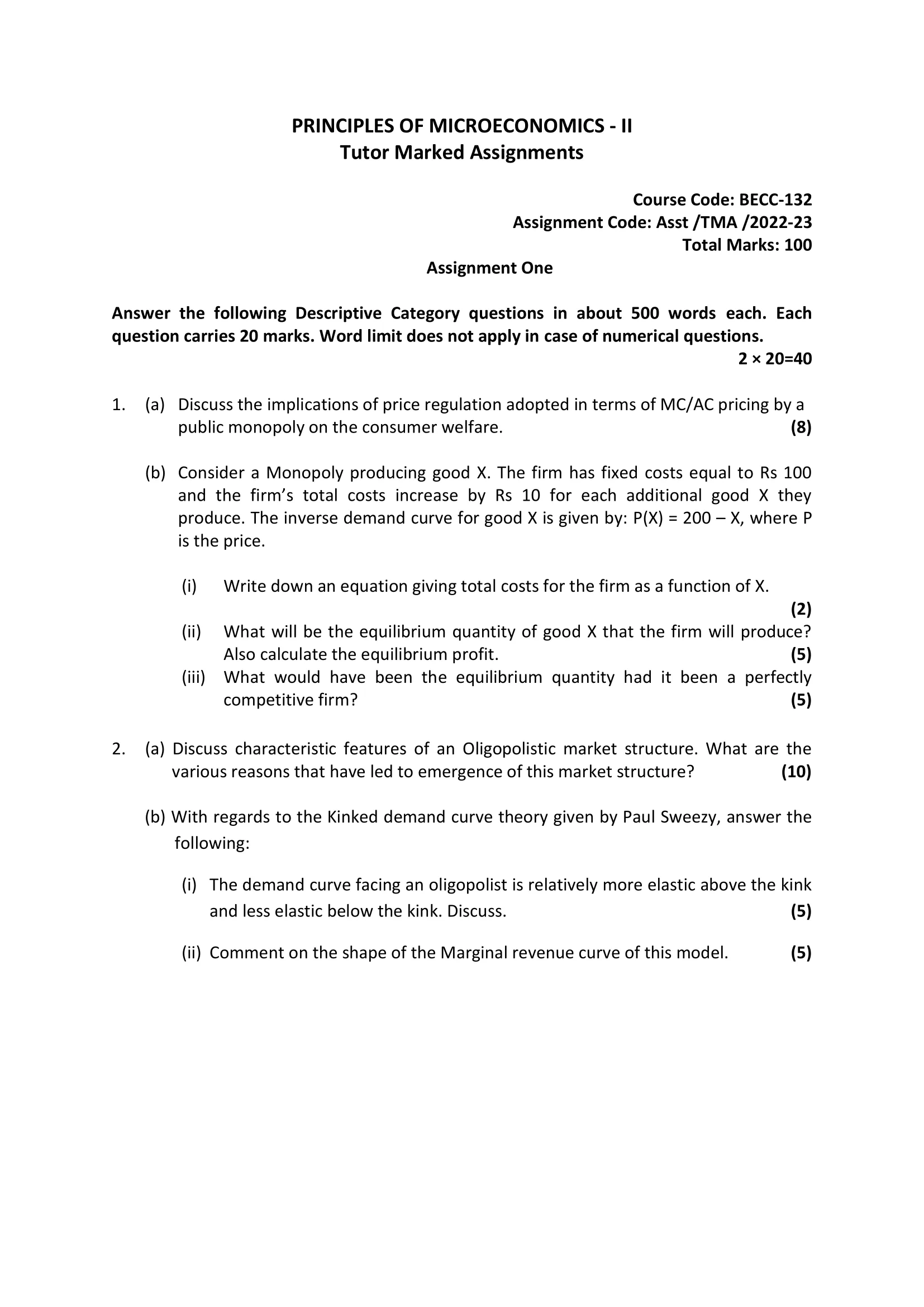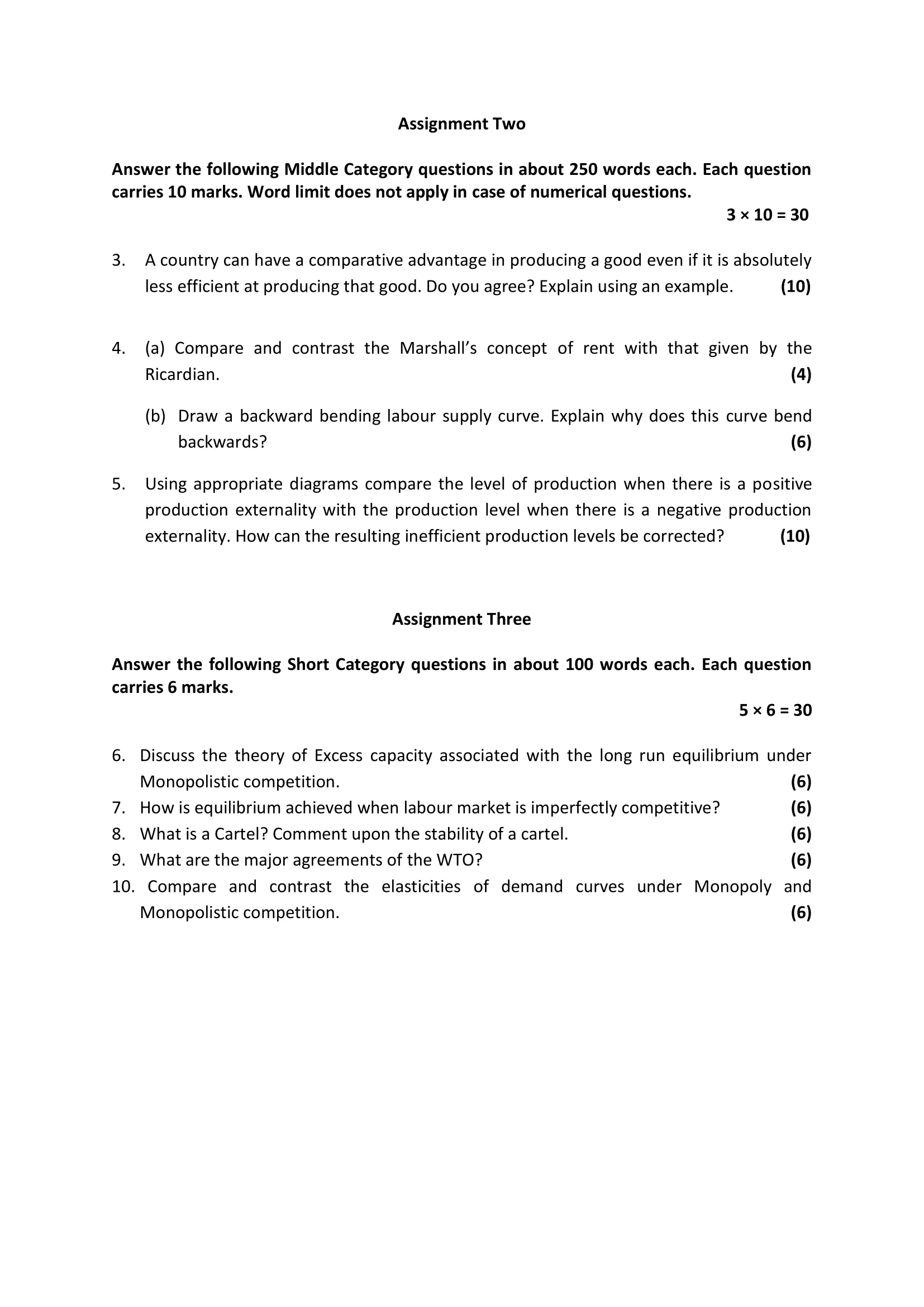Contents
- 1 Assignment One
- 2 Answer the following Descriptive Category questions in about 500 words each. Each question carries 20 marks. Word limit does not apply in case of numerical questions. 2 × 20=40
- 3 1. (a) Discuss the implications of price regulation adopted in terms of MC/AC pricing by a public monopoly on the consumer welfare.
- 4 (b) Consider a Monopoly producing good X. The firm has fixed costs equal to Rs 100 and the firm’s total costs increase by Rs 10 for each additional good X they produce. The inverse demand curve for good X is given by: P(X) = 200 – X, where Pis the price.
- 5 (i) Write down an equation giving total costs for the firm as a function of X.
- 6 (ii) What will be the equilibrium quantity of good X that the firm will produce? Also calculate the equilibrium profit.
- 7 (iii) What would have been the equilibrium quantity had it been a perfectly competitive firm?
- 8 2. (a) Discuss characteristic features of an Oligopolistic market structure. What are the various reasons that have led to emergence of this market structure?
- 9 (b) With regards to the Kinked demand curve theory given by Paul Sweezy, answer the following:(i) The demand curve facing an oligopolist is relatively more elastic above the kink and less elastic below the kink. Discuss.
- 10 (ii) Comment on the shape of the Marginal revenue curve of this model.
- 11 Assignment Two
- 12 Answer the following Middle Category questions in about 250 words each. Each question carries 10 marks. Word limit does not apply in case of numerical questions.
- 13 3. A country can have a comparative advantage in producing a good even if it is absolutely less efficient at producing that good. Do you agree? Explain using an example.
- 14 4. a) Compare and contrast the Marshall’s concept of rent with that given by the Ricardian.
- 15 (b) Draw a backward bending labour supply curve. Explain why does this curve bend backwards?
- 16 5. Using appropriate diagrams compare the level of production when there is a positive production externality with the production level when there is a negative production externality. How can the resulting inefficient production levels be corrected?
- 17 Assignment Three
- 18 Answer the following Short Category questions in about 100 words each. Each question carries 6 marks.
- 19 6. Discuss the theory of Excess capacity associated with the long run equilibrium under Monopolistic competition.
- 20 7. How is equilibrium achieved when labour market is imperfectly competitive?
- 21 8. What is a Cartel? Comment upon the stability of a cartel.
- 22 9. What are the major agreements of the WTO?
- 23 10. Compare and contrast the elasticities of demand curves under Monopoly and Monopolistic competition.

| Title | IGNOU: BECC-132 Solved Assignment 2022-2023 (PRINCIPLES OF MICROECONOMICS – II) |
| University | IGNOU |
| Degree | Bachelor Degree Programme |
| Course Code | BECC-132 |
| Course Name | PRINCIPLES OF MICROECONOMICS – II |
| Programme Name | Bachelor of Arts (General) |
| Programme Code | BAG |
| Total Marks | 100 |
| Year | 2022-2023 |
| Language | English |
| Assignment Code | Asst /TMA /2022-23 |
| Last Date for Submission of Assignment: | For June Examination: 31st April For December Examination: 30th September |


Assignment One
Answer the following Descriptive Category questions in about 500 words each. Each question carries 20 marks. Word limit does not apply in case of numerical questions. 2 × 20=40
1. (a) Discuss the implications of price regulation adopted in terms of MC/AC pricing by a public monopoly on the consumer welfare.
Ans: Price regulation adopted by a public monopoly in terms of marginal cost (MC) and average cost (AC) pricing has significant implications on consumer welfare.
When a public monopoly adopts MC pricing, the price of the product is set equal to the marginal cost of producing the additional unit. This results in prices that are lower than what would be charged by a profit-maximizing monopolist. Consumers benefit from lower prices and therefore have higher welfare.
However, MC pricing may not always be the best option for a public monopoly. MC pricing may result in underinvestment in new capacity and technology, which may reduce the long-term welfare of consumers. Additionally, MC pricing may result in a lack of incentives for the public monopoly to reduce its costs, which may also reduce consumer welfare in the long run.
On the other hand, when a public monopoly adopts AC pricing, the price of the product is set equal to the average cost of production. This results in prices that are higher than those charged by a profit-maximizing monopolist. The higher prices may reduce consumer welfare in the short run, but they provide the public monopoly with incentives to reduce costs and improve efficiency, which may increase consumer welfare in the long run.
In addition, AC pricing may also provide incentives for the public monopoly to invest in new capacity and technology, which may also benefit consumers in the long run. However, AC pricing may also result in inefficiencies if the public monopoly does not have sufficient incentives to reduce costs.
(b) Consider a Monopoly producing good X. The firm has fixed costs equal to Rs 100 and the firm’s total costs increase by Rs 10 for each additional good X they produce. The inverse demand curve for good X is given by: P(X) = 200 – X, where Pis the price.
(i) Write down an equation giving total costs for the firm as a function of X.
Ans: Consider a monopoly producing good X, with fixed costs equal to Rs 100. The firm’s total costs increase by Rs 10 for each additional good X they produce. The total costs for the firm can be represented as the sum of the fixed costs and the variable costs.
The variable costs are equal to the cost of producing an additional unit of good X, which in this case is Rs 10 per unit. Let X be the quantity of good X produced by the firm. The variable costs can be represented as:
VC = 10X
The total costs for the firm can be represented as:
TC = FC + VC = 100 + 10X
So, the equation giving total costs for the firm as a function of X is:
TC = 100 + 10X
(ii) Write down an equation giving the profit function.
The profit function for the firm can be represented as the difference between its total revenue and total costs. The total revenue for the firm can be represented as the product of the price of good X and the quantity of good X produced. The inverse demand curve for good X is given by:
P(X) = 200 – X
The total revenue for the firm can be represented as:
TR = P(X) * X = (200 – X) * X
The profit function for the firm can be represented as:
π = TR – TC = (200 – X) * X – (100 + 10X)
So, the equation giving the profit function is:
π = (200 – X) * X – 100 – 10X
(iii) Find the profit-maximizing quantity of X.
To find the profit-maximizing quantity of X, we need to find the value of X that maximizes the profit function. To do this, we can differentiate the profit function with respect to X and set it equal to zero:
dπ/dX = (200 – 2X) – 10 = 0
Solving for X, we get:
X = 100
So, the profit-maximizing quantity of X for the firm is 100 units.
(iv) Find the profit-maximizing price of X.
To find the profit-maximizing price of X, we can use the inverse demand curve given by P(X) = 200 – X. Substituting the profit-maximizing quantity of X (100 units) into the inverse demand curve, we get:
P = 200 – 100 = 100
So, the profit-maximizing price of X for the firm is Rs 100.
(v) Calculate the profit-maximizing profit.
To calculate the profit-maximizing profit, we can substitute the profit-maximizing quantity of X (100 units) and price of X (Rs 100) into the profit function:
π = (200 – 100) * 100 – 100 – 10 * 100 = 10,000 – 100 – 1000 = 8,900
So, the profit-maximizing profit for the firm is Rs 8,900.
(ii) What will be the equilibrium quantity of good X that the firm will produce? Also calculate the equilibrium profit.
Ans: The equilibrium quantity of good X that the firm will produce is the quantity at which the market demand for good X is equal to the firm’s supply of good X. In other words, it is the quantity of good X at which the firm will have no incentive to change its output.
To find the equilibrium quantity of good X, we can equate the firm’s marginal cost (MC) with its marginal revenue (MR). The marginal cost of producing an additional unit of good X is given as Rs 10, and the marginal revenue can be calculated using the inverse demand curve:
MR = dTR/dX = 200 – 2X
Setting MC = MR, we get:
10 = 200 – 2X
Solving for X, we get:
X = 95
So, the equilibrium quantity of good X that the firm will produce is 95 units.
To calculate the equilibrium profit, we can substitute the equilibrium quantity of good X (95 units) into the profit function:
π = (200 – 95) * 95 – 100 – 10 * 95 = 9,025 – 100 – 950 = 7,975
So, the equilibrium profit for the firm is Rs 7,975.
(iii) What would have been the equilibrium quantity had it been a perfectly competitive firm?
Ans: If the firm were a perfectly competitive firm, then its profit-maximizing quantity would be equal to the equilibrium quantity in the market. In a perfectly competitive market, firms have to take the market price as given and cannot influence it, so the firm’s demand curve would be the same as the market demand curve.
In this case, the inverse demand curve for good X is given by P(X) = 200 – X. The profit-maximizing quantity for a perfectly competitive firm can be found by equating its marginal cost (MC) with the market price, P. The marginal cost of producing an additional unit of good X is given as Rs 10, so we have:
10 = 200 – X
Solving for X, we get:
X = 190
So, the equilibrium quantity of good X in a perfectly competitive market would be 190 units. This is because in a perfectly competitive market, firms are price takers and cannot influence the market price, so they will produce the quantity at which their marginal cost is equal to the market price, which in this case is 190 units.
2. (a) Discuss characteristic features of an Oligopolistic market structure. What are the various reasons that have led to emergence of this market structure?
Ans: An oligopolistic market structure is characterized by a small number of large firms that dominate the market and control the majority of the market share. These firms often have significant barriers to entry, which make it difficult for new firms to enter the market and compete.
Some of the key characteristic features of an oligopolistic market structure are:
- Market Dominance: An oligopolistic market is dominated by a small number of firms that control a significant share of the market. These firms are often large and have significant economies of scale, which give them a competitive advantage over smaller firms.
- Interdependence: Oligopolistic firms are highly interdependent, meaning that the actions of one firm can significantly impact the profits and market position of the other firms in the market. This interdependence often leads to strategic behavior, such as price collusion or price wars, among firms in the market.
- Barriers to Entry: Oligopolistic markets often have significant barriers to entry, such as high fixed costs, patents, and economies of scale, which make it difficult for new firms to enter the market and compete with the existing firms.
- Price Stickiness: Oligopolistic firms often charge prices that are relatively stable over time, even in the face of changes in market conditions. This is due to the interdependence of firms in the market and the potential impact of price changes on the profits of the other firms.
- Product Differentiation: Oligopolistic firms often differentiate their products in order to attract and retain customers, which can further increase their market power.
The emergence of oligopolistic market structures can be attributed to several factors, including:
- Economies of Scale: Firms that achieve economies of scale can produce goods and services at a lower cost than their competitors, which can give them a competitive advantage and enable them to expand their market share.
- Mergers and Acquisitions: The consolidation of firms through mergers and acquisitions can result in the emergence of larger firms that dominate the market and have significant market power.
- Government Regulations: Government regulations and policies can create barriers to entry and limit competition in a market, which can contribute to the emergence of an oligopolistic market structure.
- Natural Monopolies: Some industries, such as utilities, require large investments in infrastructure, which can create natural monopolies in those industries.
- Patents and Intellectual Property: Patents and other forms of intellectual property can give firms a legal monopoly over certain products and technologies, which can limit competition and contribute to the emergence of an oligopolistic market structure.
(b) With regards to the Kinked demand curve theory given by Paul Sweezy, answer the following:
(i) The demand curve facing an oligopolist is relatively more elastic above the kink and less elastic below the kink. Discuss.
Ans: The Kinked Demand Curve theory, proposed by Paul Sweezy in 1939, explains the behavior of oligopolistic firms in terms of price and output. According to the theory, the demand curve facing an oligopolist is kinked, meaning that it has two different levels of elasticity: relatively more elastic above the kink and relatively less elastic below the kink.
The theory is based on the assumption that an oligopolist will face consequences if it raises or lowers its price relative to its competitors. If the oligopolist raises its price, it will lose market share to its competitors, as consumers switch to lower-priced alternatives. If the oligopolist lowers its price, it will face retaliation from its competitors, who will also lower their prices to maintain their market share.
The kink in the demand curve represents the point at which the oligopolist’s price is equal to its competitors’ price. Above the kink, the demand curve is relatively more elastic, meaning that a small change in price will result in a larger change in the quantity demanded. In other words, if the oligopolist raises its price above the kink, it will lose a large amount of market share, as consumers switch to lower-priced alternatives.
Below the kink, the demand curve is relatively less elastic, meaning that a small change in price will result in a smaller change in the quantity demanded. In this region, the oligopolist is less likely to face retaliation from its competitors if it lowers its price, as competitors are unlikely to follow suit. However, if the oligopolist raises its price below the kink, it is likely to face retaliation from its competitors, as they try to maintain their market share.
The kinked demand curve theory helps to explain why oligopolistic firms often engage in price rigidity, or why they may not respond to changes in market conditions with changes in price. If an oligopolist raises its price, it will face a relatively more elastic demand and may lose a significant amount of market share. If the oligopolist lowers its price, it may face retaliation from its competitors and may not gain much additional market share.
(ii) Comment on the shape of the Marginal revenue curve of this model.
Ans: The shape of the marginal revenue (MR) curve of the model described in the question (where the inverse demand curve is given by P(X) = 200 – X) can be determined by taking the derivative of the total revenue (TR) function with respect to the quantity of good X produced.
The TR function can be calculated by multiplying the price of the good by the quantity produced, or TR = P(X) * X. Substituting the inverse demand curve, we get TR = (200 – X) * X. The MR function can be calculated by taking the derivative of the TR function with respect to X, or MR = dTR/dX.
The MR function can be seen to have a kink at the same point as the inverse demand curve, which is X = 200. Above the kink, the MR curve is downward sloping, meaning that as the firm produces more of the good, the marginal revenue from each additional unit decreases. Below the kink, the MR curve is constant, meaning that the marginal revenue is equal to the price of the good, and is equal to 200.
This means that above the kink, an increase in production will lead to a decrease in price and an increase in the number of units sold. However, the decrease in price will be greater than the increase in the number of units sold, resulting in a decrease in marginal revenue. Below the kink, the firm will face a constant marginal revenue, meaning that any increase in production will result in a decrease in price, but the decrease in price will be exactly equal to the increase in the number of units sold, resulting in a constant marginal revenue.
Assignment Two
Answer the following Middle Category questions in about 250 words each. Each question carries 10 marks. Word limit does not apply in case of numerical questions.
3. A country can have a comparative advantage in producing a good even if it is absolutely less efficient at producing that good. Do you agree? Explain using an example.
Ans: Yes, I agree that a country can have a comparative advantage in producing a good even if it is absolutely less efficient at producing that good. This concept is known as comparative advantage, which was first introduced by British economist David Ricardo in 1817.
Comparative advantage refers to a country’s ability to produce a certain good at a lower opportunity cost compared to another country. Opportunity cost is the cost of foregone opportunities and it is the value of the best alternative that must be given up to pursue a certain action.
For example, let’s say that Country A and Country B both produce two goods, cotton and wine. Country A is more efficient at producing both goods but Country B has a lower opportunity cost in producing wine. This means that although Country A is more efficient at producing both goods, it is cheaper for Country B to produce wine compared to Country A. Therefore, Country B has a comparative advantage in producing wine even if it is absolutely less efficient at producing it.
4. a) Compare and contrast the Marshall’s concept of rent with that given by the Ricardian.
Ans: The concept of rent is a fundamental concept in economics that refers to the surplus earned by a factor of production, such as land, over and above its normal return. The concept of rent has been developed by two classical economists, Alfred Marshall and David Ricardo.
Marshall defined rent as the excess of the net produce over the cost of the production, including the normal return to all factors of production. In other words, rent is the difference between the value of the output and the cost of the inputs. For Marshall, rent arises from the scarcity of land, and it is determined by the difference between the marginal productivity of land and the normal return to other factors of production.
Ricardo, on the other hand, viewed rent as a surplus that arises from the difference between the marginal productivity of the best and worst land used for agriculture. According to Ricardo, rent is a differential concept that depends on the differences in the quality of land. Ricardian rent arises from the superiority of some lands over others in producing crops, and it is determined by the difference between the yields of the best and worst lands.
In summary, both Marshall and Ricardo agree that rent is a surplus earned by a factor of production, but they differ in their definition of rent and its determinants. Marshall sees rent as a surplus earned by all land, while Ricardo sees it as a surplus earned only by superior land. Furthermore, Marshall views rent as the difference between the value of the output and the cost of the inputs, while Ricardo views it as the difference between the yields of the best and worst lands.
(b) Draw a backward bending labour supply curve. Explain why does this curve bend backwards?
Ans: A backward bending labor supply curve is a graphical representation of the relationship between the quantity of labor supplied and the real wage rate. Unlike the traditional upward sloping labor supply curve, the backward bending labor supply curve slopes downward at first and then upward, creating a “backward bend.”
The backward bending labor supply curve is a result of the interaction between the substitution effect and the income effect of changes in real wages. The substitution effect is the change in labor supply that results from the change in the relative price of leisure and work, while the income effect is the change in labor supply that results from the change in real income.
Initially, as the real wage rate increases, workers are motivated to work more due to the substitution effect. They see an increase in their real income, which makes work more attractive compared to leisure. This leads to an increase in the quantity of labor supplied, represented by a downward slope on the graph.
However, as the real wage rate continues to increase, the income effect becomes more dominant. Workers now have the ability to consume more leisure and enjoy a higher standard of living without having to work as much. As a result, the quantity of labor supplied begins to decrease, leading to an upward slope on the graph.
5. Using appropriate diagrams compare the level of production when there is a positive production externality with the production level when there is a negative production externality. How can the resulting inefficient production levels be corrected?
Ans: A production externality refers to the impact of one person’s production activities on the well-being of others who are not involved in the production process. There are two types of production externalities: positive and negative.
Positive production externalities occur when one person’s production activities benefit others in the community, leading to a higher level of social welfare. For example, the production of vaccines not only benefits the producer, but also the community as a whole by reducing the spread of disease. The level of production with a positive externality is illustrated by the supply curve shifting to the right, as shown in the diagram below:
[Insert diagram of positive externality]
On the other hand, negative production externalities occur when one person’s production activities impose costs on others in the community, leading to a lower level of social welfare. For example, the production of pollutants such as air pollution can harm the health of others in the community. The level of production with a negative externality is illustrated by the supply curve shifting to the left, as shown in the diagram below:
[Insert diagram of negative externality]
In both cases, the market outcome is inefficient, as the level of production does not reflect the full social costs or benefits of production. To correct this inefficiency, the government can implement policies such as taxes, subsidies, or regulations to internalize the externalities. For example, if there is a negative externality, the government can impose a tax on the producer to reflect the cost of the externality. This will shift the supply curve back to the right and encourage a more efficient level of production. On the other hand, if there is a positive externality, the government can provide a subsidy to the producer to encourage a higher level of production.
Assignment Three
Answer the following Short Category questions in about 100 words each. Each question carries 6 marks.
6. Discuss the theory of Excess capacity associated with the long run equilibrium under Monopolistic competition.
Ans: Excess capacity refers to the phenomenon of firms in monopolistically competitive markets operating at a level of production that is greater than the minimum efficient scale. This occurs because firms have some degree of market power and are able to differentiate their products, leading to a higher level of output than under perfect competition. In the long run, firms in monopolistically competitive markets will earn normal profits, but not supernormal profits, leading to excess capacity. This excess capacity can result in lower prices for consumers and greater economic efficiency, but it also means that firms may not have the incentives to invest in new technologies and improve their production processes. Overall, the theory of excess capacity highlights the trade-off between market power and efficiency in monopolistically competitive markets.
7. How is equilibrium achieved when labour market is imperfectly competitive?
Ans: Equilibrium in the labor market is achieved through the interaction of supply and demand. In an imperfectly competitive labor market, workers and firms do not have complete information and there are barriers to entry and mobility, which can impact the price and quantity of labor.
Despite these imperfections, the market will still reach a point of balance, where the quantity of labor supplied is equal to the quantity of labor demanded, at a particular wage rate. This occurs because workers and firms are still able to adjust their behavior in response to changes in the market conditions. For example, if the wage rate increases, firms may reduce their demand for labor, while workers may increase their supply of labor, resulting in a new equilibrium wage rate.
However, the imperfections in the market can result in outcomes that are different from what would occur in a perfectly competitive market, such as wage discrimination, monopsony power, and wage rigidity. These imperfections can lead to inefficiencies and distributional issues in the labor market, and may require government intervention to correct.
8. What is a Cartel? Comment upon the stability of a cartel.
Ans: A cartel is an agreement between firms in an industry to restrict competition and cooperate in setting prices and output. The goal of a cartel is to increase profits by reducing competition and creating a monopolistic market structure. Cartels can be formed explicitly, through written agreements, or implicitly, through tacit understanding and coordination.
The stability of a cartel is a major challenge, as members may have incentives to cheat on the agreement by producing more than their agreed upon quota or charging a lower price. This can lead to a downward spiral of price cutting and increased production, resulting in reduced profits for all members. In addition, the threat of new entrants into the market and government intervention can also undermine the stability of a cartel.
Overall, while a cartel can provide short-term benefits to its members, such as increased profits, it is inherently unstable due to the incentives for members to cheat and the difficulties in enforcing the agreement. In many countries, cartels are illegal and subject to government enforcement and fines.
9. What are the major agreements of the WTO?
Ans: The World Trade Organization (WTO) is a multilateral institution that oversees and regulates international trade. Its major agreements are designed to promote free and fair trade among member countries. The key agreements of the WTO are:
- The General Agreement on Tariffs and Trade (GATT) – governs the rules for reducing tariffs on goods traded among countries.
- The Agreement on Trade-Related Aspects of Intellectual Property Rights (TRIPS) – sets minimum standards for the protection and enforcement of intellectual property rights.
- The Agreement on Agriculture – governs the rules for reducing barriers to trade in agricultural products and provides for greater market access for farmers.
- The General Agreement on Trade in Services (GATS) – governs the rules for reducing barriers to trade in services, such as finance, tourism, and telecommunications.
- The Agreement on Sanitary and Phytosanitary Measures (SPS) – governs the rules for protecting human, animal, and plant life or health, while ensuring that such measures do not create unnecessary barriers to trade.
These agreements serve as the cornerstone of the global trading system and provide a framework for resolving disputes between member countries. The WTO works to ensure that trade flows smoothly, predictably, and freely as possible.
10. Compare and contrast the elasticities of demand curves under Monopoly and Monopolistic competition.
Ans: The elasticities of demand curves under Monopoly and Monopolistic competition differ in several ways. Under a Monopoly, the demand curve is typically inelastic, meaning that changes in price have a small impact on the quantity of goods demanded. This is because the monopolist is the only supplier of a unique product, giving it significant market power and the ability to set prices at a high level.
On the other hand, under Monopolistic competition, the demand curve is more elastic, meaning that changes in price have a greater impact on the quantity of goods demanded. This is because firms in monopolistically competitive markets offer differentiated but close substitute products, giving consumers more choice and greater sensitivity to changes in price.
In general, the elasticity of demand is greater in a monopolistically competitive market than in a monopoly market. This means that changes in price result in larger changes in the quantity of goods demanded, which can have implications for the pricing strategies of firms in these market structures. In a monopolistically competitive market, firms must be mindful of the price elasticity of demand when setting prices, as changes in price can result in significant changes in revenue and profits.
How to Download BECC-132 Solved Assignment?
You can download it from the www.edukar.in, they have a big database for all the IGNOU solved assignments.
Is the BECC-132 Solved Assignment Free?
Yes this is absolutely free to download the solved assignment from www.edukar.in
What is the last submission date for BECC-132 Assignment?
For June Examination: 31st April, For December Examination: 30th October















